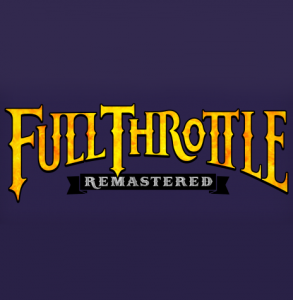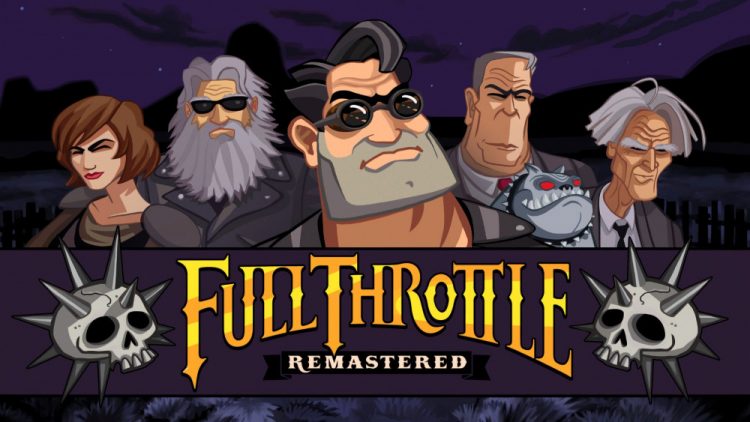LucasArts’ point-and-click adventure games in the 90s were a showcase of creativity. They let players hunt for treasure as pirates, save the world from an evil mutant tentacle, and search for Bruno the bigfoot as a private detective team made up of an anthropomorphic dog and his hyperactive, sadistic rabbit partner. I was personally a huge fan of their games, and Full Throttle (1995) is one of my all-time favorites. With Full Throttle Remastered, the game looks and sounds better than ever, but could still use just a little more polish.
 Game Name: Full Throttle Remastered
Game Name: Full Throttle Remastered
Platform(s): PS4, PC
Publisher(s): Double Fine Productions
Developer(s): Double Fine Productions
Release Date: 4/18/2017
Price: $14.99 USD
The game’s story still holds up in Full Throttle Remastered, over twenty years after its debut. Malcolm Corley, owner of motorcycle manufacturing company Corley Motors, is convinced by his business partner Adrian Ripburger (seriously!) to find a biker gang to escort him to the annual shareholders meeting. The pair meet Ben, leader of The Polecats, and although Ben and Malcolm become fast friends, Ben refuses to let his gang be ‘hired goons’ for the shareholders meeting stunt. Ben and Ripburger step outside to discuss their disagreement over the proposal, and when Ben wakes up some time later his gang is gone, heading toward a rumored ambush up the road.
Full Throttle‘s writing and characterizations shine through, all the way down to the bit players. Designer Tim Schafer explains in the first part of his playthrough of the original game that Ben is confident and strong as a break from the ‘lovable loser’ leads of Day of the Tentacle and The Secret of Monkey Island. In seeking to let the player explore their “secret desire to be a biker“, he decided to pursue expression of character through puzzle design, which meant dropping some common adventure game tropes. Instead of finding a key or other means of entry, locked doors could be kicked in; traditional dialogue puzzles were replaced by rolling fights on motorcycles.
That steadfast biker confidence is present in most of the characters. Malcolm Corley has a healthy dose of ‘free-spirited old man’ added in, while Maureen’s reclusive disposition masks her underlying take-charge nature. The stellar voice acting brings so much memorability to the characters, even those who only appear briefly in the story. The most notable performances are Roy Conrad’s deep, grumbly portrayal of Ben, and Mark Hamill’s ‘calm Joker’ approach to Ripburger.
The game is notorious for its length, or lack thereof. Whereas other titles in the same genre at the time averaged forty hours, this one came out to about eight. Even so, it managed to tell a complete story without much filler, and I always enjoy going back to replay it (a full run takes about an hour and a half when you know all of the solutions to the puzzles) just to watch the animation and hear the voice acting. Schafer noted in his playthrough video that the length of Full Throttle seems much more appropriate for the modern age of gaming, as years of increasing production values have meant shorter games overall. Advancing technology in the 90s allowed for more full-screen animation and cleaner visuals than in the past. CD-quality sound was also becoming more common, and Full Throttle‘s soundtrack added authenticity by including songs from biker band The Gone Jackals’ Bone to Pick album.
It was a welcome surprise when a remastered version of Full Throttle was announced during PlayStation Experience 2015. Following Grim Fandango Remastered and Day of the Tentacle Remastered, the update promised HD visuals and enhanced audio. So, how did Full Throttle Remastered turn out?
The original game’s visuals were impressive in 1995 for how clear and stylized they were. The low resolution engines of that era made for images that had a ‘hacksaw’ look to them, with jagged features and unclear, sometimes wholly pixelated objects. The clarity of the environments and character designs not only speaks to artist Peter Chan’s talent, but also translates exceptionally well into HD for Full Throttle Remastered. Some fans expressed concern that these remasters would simply use smoothing filters available in emulators to lazily turn up the quality, but Double Fine went the hard route here and redrew everything using the existing frames of animation as a basis. The new art was also drawn with additional content in order to fill a full 16:9 frame (the original game was in 4:3). Camera pans across the scenery have been smoothed out, but they are in stark contrast with every other low-frame animation held over from the original release.
Full Throttle Remastered, like Day of the Tentacle Remastered and Grim Fandango Remastered, allows the player to switch between the ‘remastered’ and ‘classic’ visuals and audio on the fly. Every animation is matched frame for frame and redrawn for the remaster, which may disappoint you, depending on what your expectations were. My only real complaint is that, as in previous Remastered titles, environments look like a collection of digital paint smudges in some places. This is mostly in line with the source art, but at times it looks like it could have been a little more defined. For some odd reason, a lot of the distant scenery was changed. Mountains and clouds behind characters in many of the close-up shots have been completely changed between classic and remastered modes. Also strange were some screen flashes that occurred in classic mode during scene transitions, which don’t happen in remastered mode.
Compression was a budding technology in the 90s, and I remember having mixed feelings about LucasArts’ INSANE (INteractive Streaming ANimation Engine) software. It allowed for full motion video built on the concept of only updating pixels that change between frames, but the result could be really rough on graphics rendered at 320×200 and displayed full screen on a 17″ CRT monitor. It was first used for Star Wars: Rebel Assault and its sequel, and those games had a number of scenes where the dithering and INSANE compression left things looking like a mosaic. The engine was used for full-screen animation in Full Throttle, most infamously during the Mine Rd. portion of the game in which players must ride along a decaying road to fight other bikers. In Full Throttle Remastered, frames have again been directly updated so the animation is one-to-one. While this limits the motion to the low frame rate of the original game, the HD visuals are crisp and clear.
That said, I’m not crazy about the new look of Mine Rd. The original featured a dark, stormy-looking sky, and the terrain had a very interesting quality to it. The remastered visuals brighten everything, reduce the cloud cover in the sky, and turn the walls of the canyon into an odd collection of rocks and grooves. It looked like the flatter land beyond the edge of the road was more textured in the original, and seems to be almost blank in the redraw. The road itself also doesn’t look nearly as weathered and damaged as it did before, which was part of what gave this section of the original game such a moody and gritty atmosphere.
I also want to mention graphical glitches I found during my playthrough of Full Throttle Remastered. In the image below, the remastered capture is on the left, and the classic is on the right. When the door swings open, you can see the ground at Ben’s feet is the same in both of them, as the remastered engine somehow didn’t replace that piece of the screen. It’s unfortunate to see on launch, but most likely easily fixed with a patch.
Finally, I’d like to talk about the updated audio for this release. In a word, it is fantastic. I was happy when new recordings of music in Grim Fandango Remastered were made, and enjoyed the update to Day of the Tentacle‘s MIDI soundtrack. The numerous orchestrated musical cues in Full Throttle have all been remixed with higher quality samples replacing the original low-fi instruments, and it all sounds amazing. You can listen to the classic and remastered versions of every musical cue and song in the game from the menu, as well as the game’s audio commentary track (which you can otherwise press A to hear when prompted during the game). All of the voice acting is now clear and free of compression, and the Gone Jackals tracks are played at full quality.
It’s not perfect, however. Some of the original, low-quality sound effects are still used in the remastered mode, such as the sound your bike makes when you ride over the yellow reflectors in the middle of the road. The original game’s music faded or blended between a number of scenes, but Full Throttle Remastered has hard cuts in the music in the same places. In the video below, I’ve recorded the end of one of the early cutscenes in remastered and classic modes, which both feature a hard cut in the music where there shouldn’t be one. I have also included a third recording of the game played in ScummVM, where the music doesn’t cut out. This can most likely also be fixed with a patch, which I hope will come soon.
In all, Full Throttle Remastered is a great package. The updated visuals are excellent for the most part, although animations were kept at their low frame rates and scenery can look a bit like digital paint splotches in places. The enhanced audio is superb, and you can listen to all of the game’s musical cues in the menu. The commentary track with Tim Schafer and key members of the original production team is a fun listen as well. If you’re a fan of the original or just a fan of point-and-click adventures, Full Throttle Remastered is absolutely worth picking up.
*Full Throttle Remastered was provided to us by Double Fine Productions for review purposes. For more information on how we review video games and other media/technology, please go review our Review Guideline/Scoring Policy for more info.
Buy Full Throttle Remastered: Steam, GOG, PlayStation Store
Can't Beat A Corley
Can't Beat A Corley
Pros:
- HD visuals are outstanding for the most part
- Additional art added to the sides of scenes so they fill a full 16:9 frame
- Enhanced audio features beautifully remixed orchestrations and full quality versions of The Gone Jackals’ music
- Players can switch between classic and remastered art and sound on the fly
Cons:
- Game launched with some graphical and audio glitches
- Some of the scenery could be more defined
- The new Mine Rd. lacks the atmosphere of its original incarnation
-
Can't Beat A Corley


